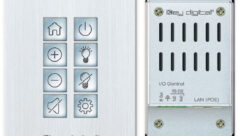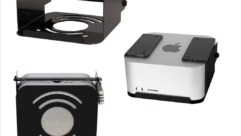Now Appearing On Your Wall
FOR SOME time now, Philips has been offering LCD TVs with a builtin, multicolor backlighting system. It’s known as AmbiLight, and while it first made its debut at CES 2004, Philips has been plugging the heck out of the technology recently.
FOR SOME time now, Philips has been offering LCD TVs with a builtin, multicolor backlighting system. It’s known as AmbiLight, and while it first made its debut at CES 2004, Philips has been plugging the heck out of the technology recently. Certain models of Philips LCD TVs equipped with AmbiLight will project light at varying levels and in six different colors onto whatever surface lies behind the TV — a wall, curtain, or glass.
When I first saw it, I had to laugh. Who would want the video equivalent of a lava lamp changing colors on the wall while trying to watch a football game or CSI? To me, AmbiLight seemed like the results of hard work by some engineers who had entirely too much time on their hands.
Actually, the concept isn’t as ridiculous as it sounds. Given the contrast limitations of the human eye (about 100:1 at best), viewing bright images in darkened rooms can create some real eyestrain problems. When the display is a CRT, light output is typically in the 80 to 100 nits (22 to 29 footlamberts) region, and eyestrain isn’t as much of an issue — particularly if there’s a low level of ambient light.
But those new plasma and LCD monitors and TVs can really crank out photons, hitting 160 nits or more (46 footlamberts). That’s considerably brighter than a CRT TV, and is three to four times brighter than a motion picture projector in a typical theater. Given the black levels in that same theater, the visual contrast ratio far exceeds the dynamic range of your eyes.
It has long been considered good engineering practice to provide some sort of backlight “relief” from overly bright electronic images when viewing monitors in darkened rooms. Veteran industry consultant and display guru Joe Kane has made a convincing case for using backlights for more than a decade, first as part of his original Imaging Science Foundation training, and now as part of his Video Essentials and Digital Video Essentials DVDs. By providing that backlight, the overall contrast ratio presented to the eye is reduced to more comfortable levels. This can be accomplished with special fluorescent lamps or other color-neutral light sources.
In any viewing environment where color accuracy is important (aren’t they all?), the TV or monitor has been calibrated for a specific color temperature and grayscale track. Given the sensitivity of the eye to even the slightest changes in color hue or tint, the backlight can’t have any inherent color bias of its own.
Philip’s 42PF9730A 42-inch LCD TV can produce some really bright images. On paper, equipping this display with AmbiLight makes sense for a critical viewing application. Of the six colors that AmbiLight cycles through automatically, one of them is a somewhat neutral gray and would probably suit the purpose — that is, if the cold-cathode backlight within the LCD TV operated at the same color temperature.
At present, none of the LCD TVs or monitors I’ve tested can produce a clean, neutral grayscale across a multi-step grayscale ramp. In contrast, this is a relatively simple task for a professional CRT monitor, once it has been calibrated. Special cold-cathode fluorescent lamps (CCFLs) are available to produce that neutral gray color at or around D6500K, which is the color temperature standard for SD and HD video.
One good thing about AmbiLight is that the intensity of the backlight can be varied by the user, or tied to the average picture level (APL) of the program or images being watched. So, Philips has the beginnings of a good idea. Now, it just needs to refine it by changing the type of backlight inside the display to light up the LCD pixels. (AmbiLight is also available on Philips’ 42PF9630A 42-inch plasma TV.)
In previous columns, I’ve mentioned light-emitting diodes (LEDs) as a strong candidate for back-lights. The color spectral energy from red, green, and blue LEDs is more evenly distributed than what you’d get from a CCFL, and it’s possible to dial in a more precise color gamut and grayscale. Hybrid backlighting systems have been proposed that would add white light from a CCFL or its cousin, the hot-cathode fluorescent lamp (HCFL), to increase image brightness. This system, which is similar to a multi-segment color wheel found in single-chip DLP projection engines, requires less effort to produce white light while conserving the power draw in the LEDs.
Could LEDs also be used for the backlight? Certainly, although to make them more power-efficient, they’d have to be operated in a pulse-width modulation mode, switching on and off several hundred times per second. The flicker wouldn’t be noticeable at that rate, but the power savings would be. Keep in mind that most people don’t view electronic displays in total darkness. I can’t think of a single digital signage application where such a backlight would be warranted. And it’s common knowledge that consumers who buy LCD TVs do so mostly because they’ll have nice bright pictures under full room lighting.
So, is Philips onto a good thing, or is this just another crazy idea from its research labs? Certainly the AmbiLight concept could be extended to a wide range of consumer TV products, including some of the new microdisplay LCD, LCoS, and DLP TVs that produce images with high brightness levels. Given the desire of Asian display manufacturers to move away from CRTs and concentrate on LCD, plasma, and microdisplay imaging for professional and broadcast applications, I’d venture to guess that a color-neutral backlight option would be very popular, particularly if the high black levels and poor grayscale tracking in today’s LCD TVs and monitors is ever tamed.
Philips’ approach of cycling between red, green, blue, gold, and other colors won’t be as popular with the broadcast and professional crowd. But it’s not hard to imagine that someone will make AmbiLight an integral part of a retail-based digital signage application, if for no other reason than to catch the eyes of passers-by. And I’m sure it’s only a matter of time before someone figures out a way to fit one into the back seat of a “low rider” limousine. (Hey Philips, how about a black light version of AmbiLight?)
Pete Putman is a contributing editor for Pro AV and president of ROAM Consulting, Doylestown, PA. Especially well known for the product testing/development services he provides manufacturers of projectors, monitors, integrated TVs, and display interfaces, he has also authored hundreds of technical articles, reviews, and columns for industry trade and consumer magazines over the last two decades. You can reach him at [email protected].










